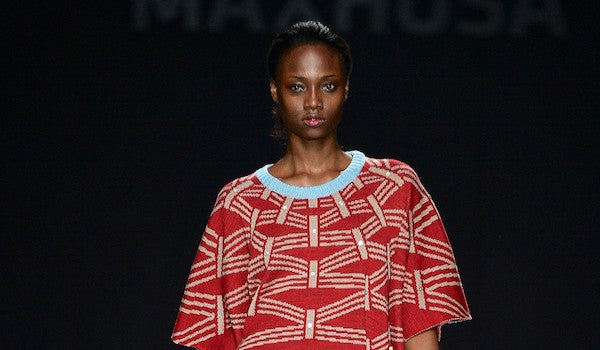
Zig Zag

The people of the Xhosa culture, predominately based on the south coast of South Africa, are known for clicks in their language as well as their intricate beadwork. Tiny seed beads make up stripes, diamonds, chevrons, arrows and zig-zags, all with their own meanings that tell you the wearer’s status, wealth and age. This pattern and colour vocabulary is echoed in the knit designs of Laduma Ngxokolo, the geometric designs woven in rows fit neatly into the linear stitch structure of knitting. The colours are also traditional, used here to be recognisable though without the attendant symbolism.
The Eastern Cape stretches from just south of Port Elizabeth to Lesotho in the north, where young men between 18 and 23 years of age undertake the ritual process of ulwaluko, passing into manhood through education and circumcision. When they attend this circumcision school, their clothes are taken away as a symbolic end to their boyhood. They are given a blanket to wear and for six months they are taught ‘manhood protocol’ by elders, at the end of which they become new men or amakrwala. The families then buy a whole new ‘grown-up’ wardrobe for their young men to wear including knitwear, with Lyle and Pringle being the top imported brands. These young men are influenced by global trends and want to wear contemporary styles.

A textile graduate from South Africa’s Nelson Mandela Metropolitan University and Central St Martins, Laduma Ngxokolo wanted to incorporate the western influenced fashion sense of an amarkrwala with the regional Xhosa aesthetic. With his new MaXhosa range he has done just that and young men can wear the traditional colours and patterns from their own heritage. As well as highlighting regional heritage, the materials are local too as the range is made from a blend of Merino and kid mohair.
The Cape also produces over 50% of the world’s mohair from angora goats – not to be confused with angora wool from rabbits – most of which is exported since there is little established textile infrastructure in South Africa. The angora goats are reared predominantly in the Karoo region, between Cape Town and Port Elizabeth and produce what is considered one of the most luxurious fibres in the world. The use of natural materials that are locally produced, soft, breathable and withstand washing well, makes for a sustainable and successful business model as well as a durable quality product.

Extract from the Geometric issue. Words by Katy Bevan, images by Andile Buka.
To read more stories like this, subscribe to Selvedge here. Use the offer code BLOG for 10% off any fixed-term subscription (does not apply to recurring subscriptions).
